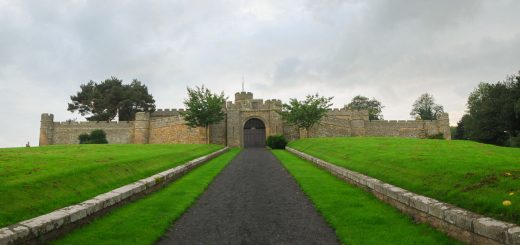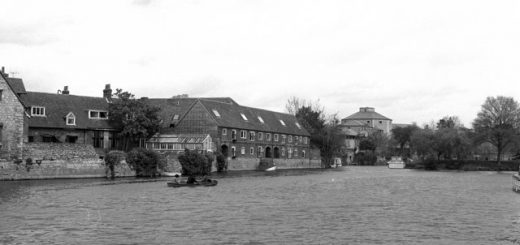50 Berkeley Square
During the Victorian era 50 Berkeley Square was popularly believed to be the most haunted building in London. Now occupied by the famous antiquarian book dealers, Maggs Bros, there is no evidence that haunting like experiences persist but the case of the haunting of 50 Berkeley Square, which has probably developed into a kind of urban legend has become infamous.
Berkeley Square was designed by the architect William Kent (born 1685 – died 12 April 1748) in the mid 1700’s. 50 Berkeley is a four-storey town house which was built in 1740 and its most famous resident was the Prime Minister George Canning who died on 8 August 1827 at Chiswick House.
Following Canning, the house was owned by Miss Curzon until she died aged ninety in 1859. It was during her time in Berkeley Square that the first stories of it’s ghosts came to light (circa 1840). Some sources suggest that the house remained empty following her death until 1880 though this is may not be the case.
 Following Curzon’s death the house gained a reputation for a haunted second floor (or top floor) room around which many of the stories relating the ghost revolve. There are even different stories available that are said to explain the origins of the room’s disturbances.
Following Curzon’s death the house gained a reputation for a haunted second floor (or top floor) room around which many of the stories relating the ghost revolve. There are even different stories available that are said to explain the origins of the room’s disturbances.
One of these origin stories relates to an eccentric man named Myers who rented the building at some point after 1859. When his bride to be refused to marry him and broke of their engagement he became a recluse staying in the upper room, only coming out to wander at night. Another origins tale concerns a Mr Dupre (or Du Pre) of Wilton Park in the 1700’s (possibly) who used the ‘haunted’ room to confine his violently insane brother who remained behind as a ghost.
Tales of supernatural death are said to surround the room. One new maid servant was said to have been staying in the room and one night her screams of terror awoke the whole household. They found her in the middle of the room, lying on the floor in a state of shock. She described what she saw as “horrible”, then died in St Georges Hospital the next day.
Another tale of death associated to the room is that of Sir Robert Warboys of Warboys Hall (or sometimes Captain Raymond or Captain Kentfield depending upon the version you hear). He took a wager between Lord Cholmondley and John Benson (of 50 Berkeley Square) for 100 guineas that he could spend a night in the haunted room. Armed with a bell to raise the alarm if he saw anything and a pistol for further protection, he retired to the haunted room. Upon hearing the bell ringing and the pistol being fired his companions rand to his aid, only to find Sir Robert hanging from the bed after dying of fright.
One survivor of the room is said to be the rake, seducer and Member of Parliament “the wicked Lord Lyttelton” or more properly Thomas Lyttelton, 2nd Baron Lyttelton of Frankley (born 30 January 1744 – died 27 November 1779). Armed with two blunderbuss loaded with silver coins he is said to have shot some ‘thing’ in the room during the night and saw it fall, though no evidence of the thing he fired upon was discovered the following morning. Lyttelton is also said to have had another brush with paranormal, having a prophetic dream on 24th November 1779 where a bird and a woman in white told him he would die in three days time. He was already suffering from ill health and travelled to his mansion in Epsom, Pit Place where he died of a fit, as prophesized on 27 November 1779.
In his 1956 ‘Phantoms of the Night’ Elliot O’ Donnell tells the story of, two sailors (Edward Blunden and Robert Martin) from HMS Penelope who had arrived back in London from the West Indies and desperate for somewhere to stay found themselves in the empty 50 Berkeley Square, in the room at the top of the building. They heard footsteps withn the house and coming up the stairs, then something entered their room. Terrified, Martin ran passed it, out the door, down the stairs and out of the building. Equally frightened, Blunden was trapped in the room. He fell from the top window dying. Martin was then arrested for the murder of his friend.
Other haunting like experiences supposedly associated with the house include the sounds of moving furniture, ringing bells, cries from behind locked doors, windows banging open items such as furniture being thrown onto the street from the windows and figures being seen in period costume peering from the windows.
There is said to be a ghost connected to 50 Berkeley Square known as Adeline who is seen hanging from the window screaming. Whilst alive she had been a relative captive of her uncle in the house. He would make sexual advances on her and one night, whilst attempting to escape she died climbing out of the window.
Another ghost is said to be that of a yound girl who was frightened to death by a servant. She is said to appear in the upper parts of the building wearing Scots plaid and cries. These last two ghosts appeared in Jessie Adelaide Middleton’s Grey Ghost Book.
“The mystery of Berkeley Square still remains a mystery. The story of the haunted house in Mayfair can be recapitulated in a few words; the house contains at least one room of which the atmosphere is supernaturally fatal to body and mind. A girl saw, heard and felt such horror in it that she went mad, and never recovered sanity enough to tell how or why.”
“A gentleman, a disbeliever in ghosts, dared to sleep in number 50 and was found a corpse in the middle of the floor after frantically ringing for help in vain. Rumour suggests other cases of the same kind, all ending in death, madness, or both as a result of sleeping, or trying to sleep in that room. The very party walls of the house, when touched, are found saturated with electric horror. It is uninhabited save by an elderly man and his wife who act as caretakers; but even these have no access to the room. This is kept locked, the key being in the hands of a mysterious and seemingly nameless person who comes to the house once every six months, locks up the elderly couple in the basement, and then unlocks the room and occupies himself in it for hours.” – I have seen this quote attributed to both Mayfair Magazine’ 1879 and Notes and Queries circa 1870’s.




Re: 50 Berkeley Square
You don’t need a Ghost to scare you at Maggs Bros these days, just look at the prices of their books.